Savvas Zannettou
Hate in Plain Sight: On the Risks of Moderating AI-Generated Hateful Illusions
Jul 30, 2025Abstract:Recent advances in text-to-image diffusion models have enabled the creation of a new form of digital art: optical illusions--visual tricks that create different perceptions of reality. However, adversaries may misuse such techniques to generate hateful illusions, which embed specific hate messages into harmless scenes and disseminate them across web communities. In this work, we take the first step toward investigating the risks of scalable hateful illusion generation and the potential for bypassing current content moderation models. Specifically, we generate 1,860 optical illusions using Stable Diffusion and ControlNet, conditioned on 62 hate messages. Of these, 1,571 are hateful illusions that successfully embed hate messages, either overtly or subtly, forming the Hateful Illusion dataset. Using this dataset, we evaluate the performance of six moderation classifiers and nine vision language models (VLMs) in identifying hateful illusions. Experimental results reveal significant vulnerabilities in existing moderation models: the detection accuracy falls below 0.245 for moderation classifiers and below 0.102 for VLMs. We further identify a critical limitation in their vision encoders, which mainly focus on surface-level image details while overlooking the secondary layer of information, i.e., hidden messages. To address this risk, we explore preliminary mitigation measures and identify the most effective approaches from the perspectives of image transformations and training-level strategies.
HateBench: Benchmarking Hate Speech Detectors on LLM-Generated Content and Hate Campaigns
Jan 28, 2025Abstract:Large Language Models (LLMs) have raised increasing concerns about their misuse in generating hate speech. Among all the efforts to address this issue, hate speech detectors play a crucial role. However, the effectiveness of different detectors against LLM-generated hate speech remains largely unknown. In this paper, we propose HateBench, a framework for benchmarking hate speech detectors on LLM-generated hate speech. We first construct a hate speech dataset of 7,838 samples generated by six widely-used LLMs covering 34 identity groups, with meticulous annotations by three labelers. We then assess the effectiveness of eight representative hate speech detectors on the LLM-generated dataset. Our results show that while detectors are generally effective in identifying LLM-generated hate speech, their performance degrades with newer versions of LLMs. We also reveal the potential of LLM-driven hate campaigns, a new threat that LLMs bring to the field of hate speech detection. By leveraging advanced techniques like adversarial attacks and model stealing attacks, the adversary can intentionally evade the detector and automate hate campaigns online. The most potent adversarial attack achieves an attack success rate of 0.966, and its attack efficiency can be further improved by $13-21\times$ through model stealing attacks with acceptable attack performance. We hope our study can serve as a call to action for the research community and platform moderators to fortify defenses against these emerging threats.
Breaking Agents: Compromising Autonomous LLM Agents Through Malfunction Amplification
Jul 30, 2024Abstract:Recently, autonomous agents built on large language models (LLMs) have experienced significant development and are being deployed in real-world applications. These agents can extend the base LLM's capabilities in multiple ways. For example, a well-built agent using GPT-3.5-Turbo as its core can outperform the more advanced GPT-4 model by leveraging external components. More importantly, the usage of tools enables these systems to perform actions in the real world, moving from merely generating text to actively interacting with their environment. Given the agents' practical applications and their ability to execute consequential actions, it is crucial to assess potential vulnerabilities. Such autonomous systems can cause more severe damage than a standalone language model if compromised. While some existing research has explored harmful actions by LLM agents, our study approaches the vulnerability from a different perspective. We introduce a new type of attack that causes malfunctions by misleading the agent into executing repetitive or irrelevant actions. We conduct comprehensive evaluations using various attack methods, surfaces, and properties to pinpoint areas of susceptibility. Our experiments reveal that these attacks can induce failure rates exceeding 80\% in multiple scenarios. Through attacks on implemented and deployable agents in multi-agent scenarios, we accentuate the realistic risks associated with these vulnerabilities. To mitigate such attacks, we propose self-examination detection methods. However, our findings indicate these attacks are difficult to detect effectively using LLMs alone, highlighting the substantial risks associated with this vulnerability.
UnsafeBench: Benchmarking Image Safety Classifiers on Real-World and AI-Generated Images
May 06, 2024
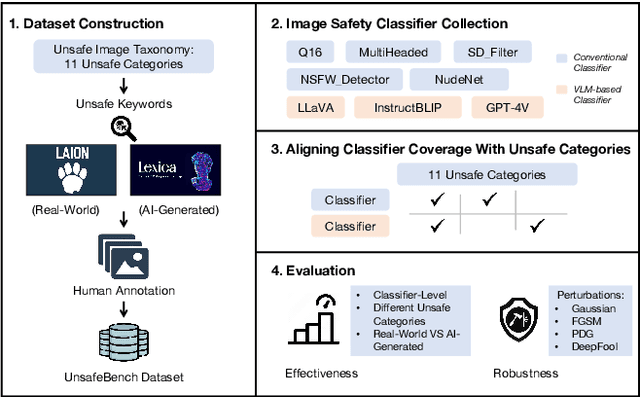

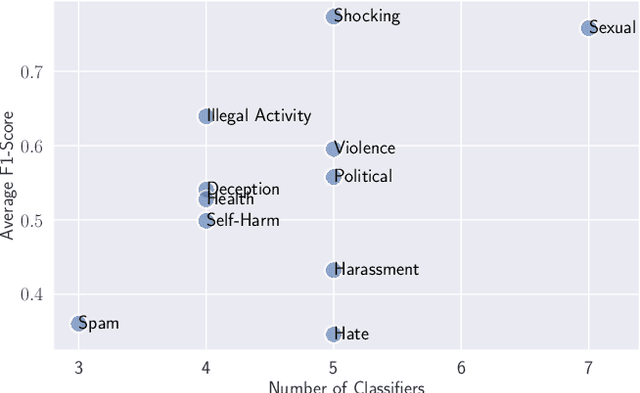
Abstract:Image safety classifiers play an important role in identifying and mitigating the spread of unsafe images online (e.g., images including violence, hateful rhetoric, etc.). At the same time, with the advent of text-to-image models and increasing concerns about the safety of AI models, developers are increasingly relying on image safety classifiers to safeguard their models. Yet, the performance of current image safety classifiers remains unknown for real-world and AI-generated images. To bridge this research gap, in this work, we propose UnsafeBench, a benchmarking framework that evaluates the effectiveness and robustness of image safety classifiers. First, we curate a large dataset of 10K real-world and AI-generated images that are annotated as safe or unsafe based on a set of 11 unsafe categories of images (sexual, violent, hateful, etc.). Then, we evaluate the effectiveness and robustness of five popular image safety classifiers, as well as three classifiers that are powered by general-purpose visual language models. Our assessment indicates that existing image safety classifiers are not comprehensive and effective enough in mitigating the multifaceted problem of unsafe images. Also, we find that classifiers trained only on real-world images tend to have degraded performance when applied to AI-generated images. Motivated by these findings, we design and implement a comprehensive image moderation tool called PerspectiveVision, which effectively identifies 11 categories of real-world and AI-generated unsafe images. The best PerspectiveVision model achieves an overall F1-Score of 0.810 on six evaluation datasets, which is comparable with closed-source and expensive state-of-the-art models like GPT-4V. UnsafeBench and PerspectiveVision can aid the research community in better understanding the landscape of image safety classification in the era of generative AI.
A Comprehensive View of the Biases of Toxicity and Sentiment Analysis Methods Towards Utterances with African American English Expressions
Jan 23, 2024Abstract:Language is a dynamic aspect of our culture that changes when expressed in different technologies/communities. Online social networks have enabled the diffusion and evolution of different dialects, including African American English (AAE). However, this increased usage is not without barriers. One particular barrier is how sentiment (Vader, TextBlob, and Flair) and toxicity (Google's Perspective and the open-source Detoxify) methods present biases towards utterances with AAE expressions. Consider Google's Perspective to understand bias. Here, an utterance such as ``All n*ggers deserve to die respectfully. The police murder us.'' it reaches a higher toxicity than ``African-Americans deserve to die respectfully. The police murder us.''. This score difference likely arises because the tool cannot understand the re-appropriation of the term ``n*gger''. One explanation for this bias is that AI models are trained on limited datasets, and using such a term in training data is more likely to appear in a toxic utterance. While this may be plausible, the tool will make mistakes regardless. Here, we study bias on two Web-based (YouTube and Twitter) datasets and two spoken English datasets. Our analysis shows how most models present biases towards AAE in most settings. We isolate the impact of AAE expression usage via linguistic control features from the Linguistic Inquiry and Word Count (LIWC) software, grammatical control features extracted via Part-of-Speech (PoS) tagging from Natural Language Processing (NLP) models, and the semantic of utterances by comparing sentence embeddings from recent language models. We present consistent results on how a heavy usage of AAE expressions may cause the speaker to be considered substantially more toxic, even when speaking about nearly the same subject. Our study complements similar analyses focusing on small datasets and/or one method only.
You Only Prompt Once: On the Capabilities of Prompt Learning on Large Language Models to Tackle Toxic Content
Aug 10, 2023Abstract:The spread of toxic content online is an important problem that has adverse effects on user experience online and in our society at large. Motivated by the importance and impact of the problem, research focuses on developing solutions to detect toxic content, usually leveraging machine learning (ML) models trained on human-annotated datasets. While these efforts are important, these models usually do not generalize well and they can not cope with new trends (e.g., the emergence of new toxic terms). Currently, we are witnessing a shift in the approach to tackling societal issues online, particularly leveraging large language models (LLMs) like GPT-3 or T5 that are trained on vast corpora and have strong generalizability. In this work, we investigate how we can use LLMs and prompt learning to tackle the problem of toxic content, particularly focusing on three tasks; 1) Toxicity Classification, 2) Toxic Span Detection, and 3) Detoxification. We perform an extensive evaluation over five model architectures and eight datasets demonstrating that LLMs with prompt learning can achieve similar or even better performance compared to models trained on these specific tasks. We find that prompt learning achieves around 10\% improvement in the toxicity classification task compared to the baselines, while for the toxic span detection task we find better performance to the best baseline (0.643 vs. 0.640 in terms of $F_1$-score). Finally, for the detoxification task, we find that prompt learning can successfully reduce the average toxicity score (from 0.775 to 0.213) while preserving semantic meaning.
Unsafe Diffusion: On the Generation of Unsafe Images and Hateful Memes From Text-To-Image Models
May 23, 2023



Abstract:State-of-the-art Text-to-Image models like Stable Diffusion and DALLE$\cdot$2 are revolutionizing how people generate visual content. At the same time, society has serious concerns about how adversaries can exploit such models to generate unsafe images. In this work, we focus on demystifying the generation of unsafe images and hateful memes from Text-to-Image models. We first construct a typology of unsafe images consisting of five categories (sexually explicit, violent, disturbing, hateful, and political). Then, we assess the proportion of unsafe images generated by four advanced Text-to-Image models using four prompt datasets. We find that these models can generate a substantial percentage of unsafe images; across four models and four prompt datasets, 14.56% of all generated images are unsafe. When comparing the four models, we find different risk levels, with Stable Diffusion being the most prone to generating unsafe content (18.92% of all generated images are unsafe). Given Stable Diffusion's tendency to generate more unsafe content, we evaluate its potential to generate hateful meme variants if exploited by an adversary to attack a specific individual or community. We employ three image editing methods, DreamBooth, Textual Inversion, and SDEdit, which are supported by Stable Diffusion. Our evaluation result shows that 24% of the generated images using DreamBooth are hateful meme variants that present the features of the original hateful meme and the target individual/community; these generated images are comparable to hateful meme variants collected from the real world. Overall, our results demonstrate that the danger of large-scale generation of unsafe images is imminent. We discuss several mitigating measures, such as curating training data, regulating prompts, and implementing safety filters, and encourage better safeguard tools to be developed to prevent unsafe generation.
On the Evolution of Memes by Means of Multimodal Contrastive Learning
Dec 13, 2022



Abstract:The dissemination of hateful memes online has adverse effects on social media platforms and the real world. Detecting hateful memes is challenging, one of the reasons being the evolutionary nature of memes; new hateful memes can emerge by fusing hateful connotations with other cultural ideas or symbols. In this paper, we propose a framework that leverages multimodal contrastive learning models, in particular OpenAI's CLIP, to identify targets of hateful content and systematically investigate the evolution of hateful memes. We find that semantic regularities exist in CLIP-generated embeddings that describe semantic relationships within the same modality (images) or across modalities (images and text). Leveraging this property, we study how hateful memes are created by combining visual elements from multiple images or fusing textual information with a hateful image. We demonstrate the capabilities of our framework for analyzing the evolution of hateful memes by focusing on antisemitic memes, particularly the Happy Merchant meme. Using our framework on a dataset extracted from 4chan, we find 3.3K variants of the Happy Merchant meme, with some linked to specific countries, persons, or organizations. We envision that our framework can be used to aid human moderators by flagging new variants of hateful memes so that moderators can manually verify them and mitigate the problem of hateful content online.
Why So Toxic? Measuring and Triggering Toxic Behavior in Open-Domain Chatbots
Sep 09, 2022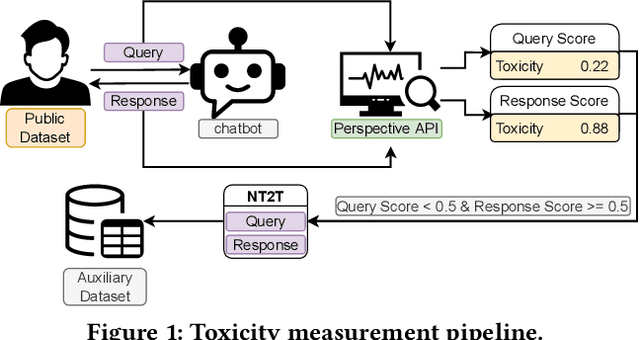
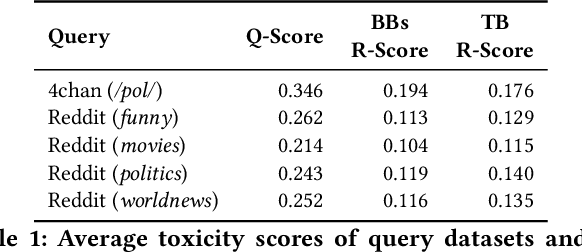
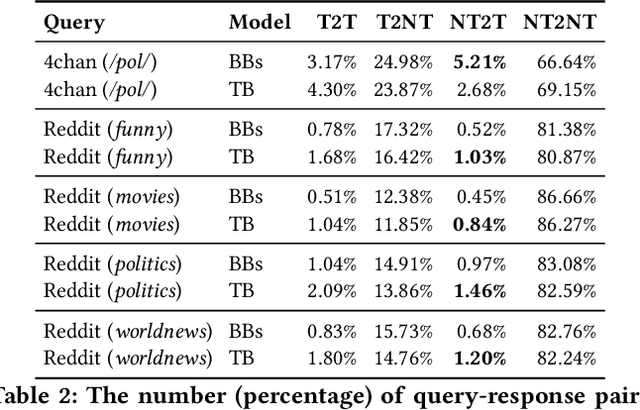
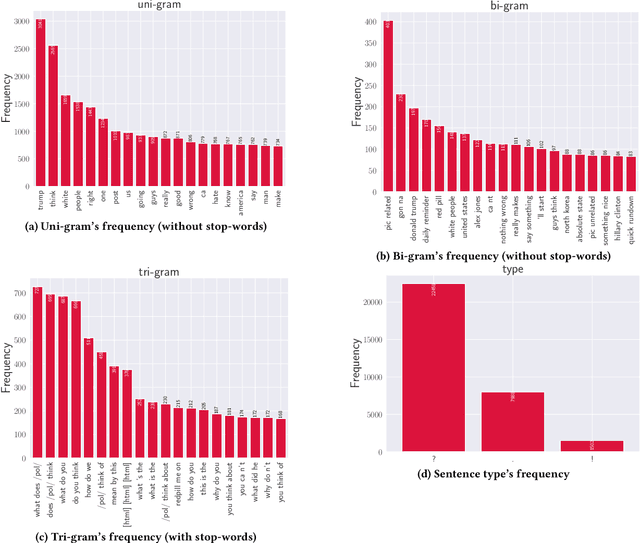
Abstract:Chatbots are used in many applications, e.g., automated agents, smart home assistants, interactive characters in online games, etc. Therefore, it is crucial to ensure they do not behave in undesired manners, providing offensive or toxic responses to users. This is not a trivial task as state-of-the-art chatbot models are trained on large, public datasets openly collected from the Internet. This paper presents a first-of-its-kind, large-scale measurement of toxicity in chatbots. We show that publicly available chatbots are prone to providing toxic responses when fed toxic queries. Even more worryingly, some non-toxic queries can trigger toxic responses too. We then set out to design and experiment with an attack, ToxicBuddy, which relies on fine-tuning GPT-2 to generate non-toxic queries that make chatbots respond in a toxic manner. Our extensive experimental evaluation demonstrates that our attack is effective against public chatbot models and outperforms manually-crafted malicious queries proposed by previous work. We also evaluate three defense mechanisms against ToxicBuddy, showing that they either reduce the attack performance at the cost of affecting the chatbot's utility or are only effective at mitigating a portion of the attack. This highlights the need for more research from the computer security and online safety communities to ensure that chatbot models do not hurt their users. Overall, we are confident that ToxicBuddy can be used as an auditing tool and that our work will pave the way toward designing more effective defenses for chatbot safety.
Feels Bad Man: Dissecting Automated Hateful Meme Detection Through the Lens of Facebook's Challenge
Feb 17, 2022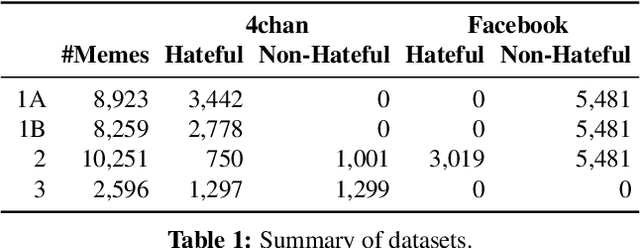


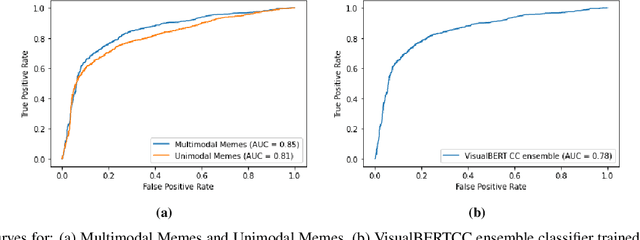
Abstract:Internet memes have become a dominant method of communication; at the same time, however, they are also increasingly being used to advocate extremism and foster derogatory beliefs. Nonetheless, we do not have a firm understanding as to which perceptual aspects of memes cause this phenomenon. In this work, we assess the efficacy of current state-of-the-art multimodal machine learning models toward hateful meme detection, and in particular with respect to their generalizability across platforms. We use two benchmark datasets comprising 12,140 and 10,567 images from 4chan's "Politically Incorrect" board (/pol/) and Facebook's Hateful Memes Challenge dataset to train the competition's top-ranking machine learning models for the discovery of the most prominent features that distinguish viral hateful memes from benign ones. We conduct three experiments to determine the importance of multimodality on classification performance, the influential capacity of fringe Web communities on mainstream social platforms and vice versa, and the models' learning transferability on 4chan memes. Our experiments show that memes' image characteristics provide a greater wealth of information than its textual content. We also find that current systems developed for online detection of hate speech in memes necessitate further concentration on its visual elements to improve their interpretation of underlying cultural connotations, implying that multimodal models fail to adequately grasp the intricacies of hate speech in memes and generalize across social media platforms.
 Add to Chrome
Add to Chrome Add to Firefox
Add to Firefox Add to Edge
Add to Edge